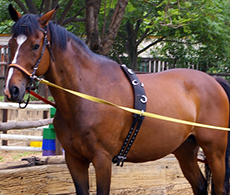
Step-by-step guide to long-reining
Long-reining offers a host of benefits for both young and experienced horses. Here’s a simple guide to help you get started and long-rein with confidence.
What is long-reining?
Long-reining is a method of exercising and educating your horse from the ground. Whether your horse is experienced or just starting out, long-reining is a great way to train your horse and keep them fit and supple without the weight of a rider. Plus, it allows you to see your horse working from the ground.
What equipment do you need for long-reining?
- Snaffle bridle with reins removed
- Roller with rings large enough for the long-rein clips to fit through and a pad underneath – or if you’re long-reining a young horse, using a saddle can help them get used to tack.
- Pair of long-reins or two padded lunge lines
- Protective boots or bandages (optional)
- Hat
- Gloves
- Sturdy boots
Benefits of long-reining
Like lunging, long-reining is a great way to exercise your horse if you’re unable to ride for any reason or you’re bringing your horse back into work. The main benefit of long-reining over lunging is that you can work your horse in a straight line, plus you can long-rein in an arena or around tracks or fields. It’s a great way to introduce a young horse to new things and a nice way to add variety to an older horse’s training.
How to long-rein a horse
- Getting started. Working on the assumption that your horse hasn’t long-reined before, take things slowly and ask a helper to stand at your horse’s head. Allow your horse to get used to the feel of the lines against their shoulders, ribs and quarters by moving the lines over their body. Once your horse is happy, pass the lines through the roller and attach them to the bit rings while standing to their side. As you move into position behind your horse, let the rein slip over their quarters and into place.
- Find your position. For the best quality contact (your horse should be able to feel the contact from your hands, rather than the weight of the line), you want to be as close to your horse as possible without being within kicking range. Hold the lines as if they were your reins, keep your elbows bent and arms relaxed. Fold the lines into loops to prevent standing on them.
- Time to move. It’s a good idea initially to have a friend lead your horse while you’re giving commands from behind, to make sure your horse understands what you’re asking. Your voice is your main aid, but you can also use little flicks of the reins on their side to back that up. Carry a lunge whip if you need further reinforcement.
- Change direction. Once you’re confidently moving around the school, try out some changes of rein. Think of your inside line as your inside leg – pressure with this asks your horse to bend. To change direction, move slightly to your horse’s outside, allowing the inside line to make contact with their hindquarter. The pressure of the line on their body prompts them to step under with their inside hindleg to make the turn. Similar to when you’re riding, your inside rein controls the bend, while your outside rein is responsible for maintaining straightness and speed through the turn. As your horse comes across to change the rein, drop back directly behind them, then move to the outside as you switch reins, ready to turn again.
- Work on a circle. Once you’ve mastered moving in a straight line, you can progress to working on a circle – it’s similar to lunging, but with two lines you can maintain a rein contact on the outside rein as well as the inside. Keep the lines light and gently follow the movement of your horse on the circle to prevent the circle becoming too small.
Stepping it up
There are a few ways you can make long-reining sessions more interesting once you’ve cracked the basics. Incorporating pole work is great for improving suppleness, supporting rehabilitation and keeping your horse’s attention.
Likewise, venturing out of the arena is a great way to introduce a young or spooky horse to new things. It’s also good for building fitness in preparation for ridden work. It’s best to have a helper with you the first time you try it. Start in the arena and, once you’re feeling confident and your horse is listening to you, the helper can reduce their input.
Fancy giving long-reining a go? We’d love to hear how you get on – let us know!



